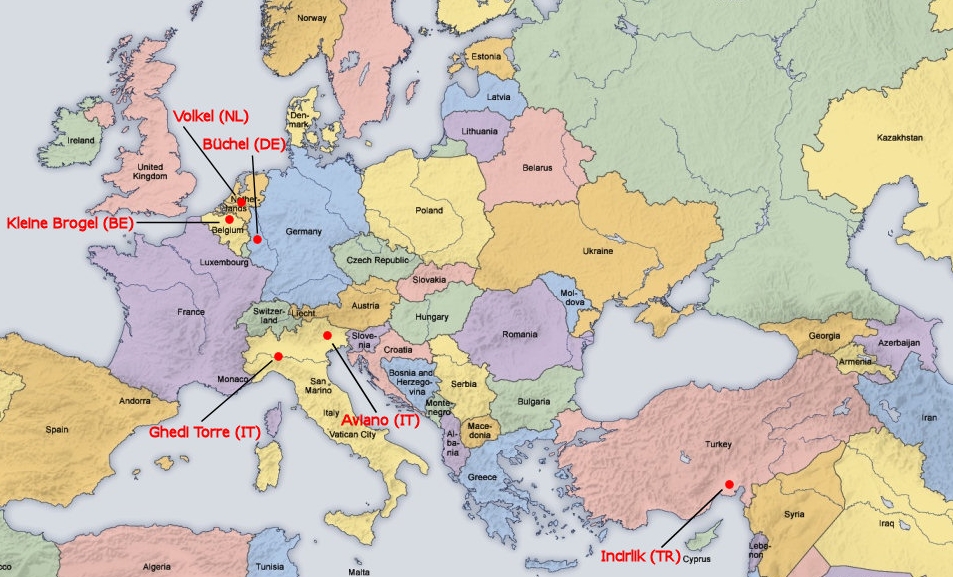
US nuclear weapons in Europe
Double standards: The United States and its allies should look at their own nuclear policy before criticizing Iran
by Mersiha Gadzo, 13 September 2010
For years, the United States and its allies have accused Iran of being a major nuclear threat because it has violated the Nuclear Non-Proliferation Treaty. Ironically, the real violators of the NNPT are the same nations accusing Iran. The U.S. and its allies have never been able to confirm their accusations with concrete proof since they are based entirely on suspicion. While the media continues to attack Iran, illegal nuclear activities made by the West remain widely unknown to the public.
Iran, unlike Israel, is a signatory of the 1970 NNPT, which requires the International Atomic Energy Agency to make frequent unannounced inspections in order to verify that the country’s nuclear program remains within the bounds of the treaty. The IAEA has made over 2,700 snap inspections in Iran and have repeatedly stated that they have found no evidence of a weapons program and that non-diversion of nuclear material is continually being verified.
United Nations Security Council investigations, led by former Director General of IAEA, Mohamed El-Baradei, have repeatedly shown that Iran has no military component to its program. In an interview for the German magazine, Der Spiegel, in July 2010, El-Baradei stated “I do not believe that the Iranians are actually producing nuclear weapons… in general, the danger of a nuclear-armed Iran is overestimated, some even play it up intentionally.”
One of the treaty’s main principles is non-proliferation. This means the five nuclear weapon states (U.S., France, United Kingdom, Russia, and China) agree not to transfer nuclear weapons. Yet the IAEA and the media have completely disregarded that the U.S. has actively been contributing to the proliferation of nuclear arms in Europe. The U.S. has thus far supplied 480 thermonuclear bombs to the so-called “non-nuclear states”: Belgium, Germany, Holland, Italy, and Turkey.
According to University of Ottawa emeritus professor Michel Chossudovsky, three out of the eight U.S. nuclear air bases are situated in Germany. While Germany imports nuclear weapons from the U.S., it also produces nuclear warheads, which are exported to France. Germany is fully capable of directing its stockpiled American nuclear warheads at the Middle East, yet Germany is recognized as a non-nuclear state.
Israel, an “undeclared nuclear state,” has obtained an estimate of 200 nuclear devices and has the Middle East’s largest and most advanced chemical and biological warfare facilities. Its refusal to sign the 189-nation NNPT enables it to easily threaten its neighbours. El-Baradei stated at a press conference in October 2009 that, “Israel is the number one threat to the Middle East given the nuclear arms it possesses.” Israel has refused to allow inspections into its nuclear program for 30 years, while Iran is complying with its obligations and allowing inspectors into its nuclear sites.
Iran has never launched a war in modern times but since 1900 has been invaded by Britain, the Soviet Union, Russia, and Iraq. It is surrounded by nuclear powers such as Israel, Pakistan, India, and Russia. The former three have yet to sign the treaty.
The signatories of the treaty are required to gradually eliminate all of their nuclear weapons and yet 40 years later none of the original signers (U.S., Britain, France, the Soviet Union, and China) have complied. Instead, all of them have steadily enhanced their nuclear arms.
The U.S. has invaded other countries, most recently Afghanistan and Iraq, and is the only nation to ever use a nuclear weapon against another nation. The U.S. is also notorious for organizing coups against democratically elected governments, overthrowing regimes, and waging illegal wars. The U.S. has no right to bully Iran when the U.S. itself is a major violator of the NNPT and of international law. Therefore, it is a double standard for the United States and its allies to curtail Iran developing peaceful nuclear technology.

 Homepage:
Homepage:

Comments
Display the following 4 comments